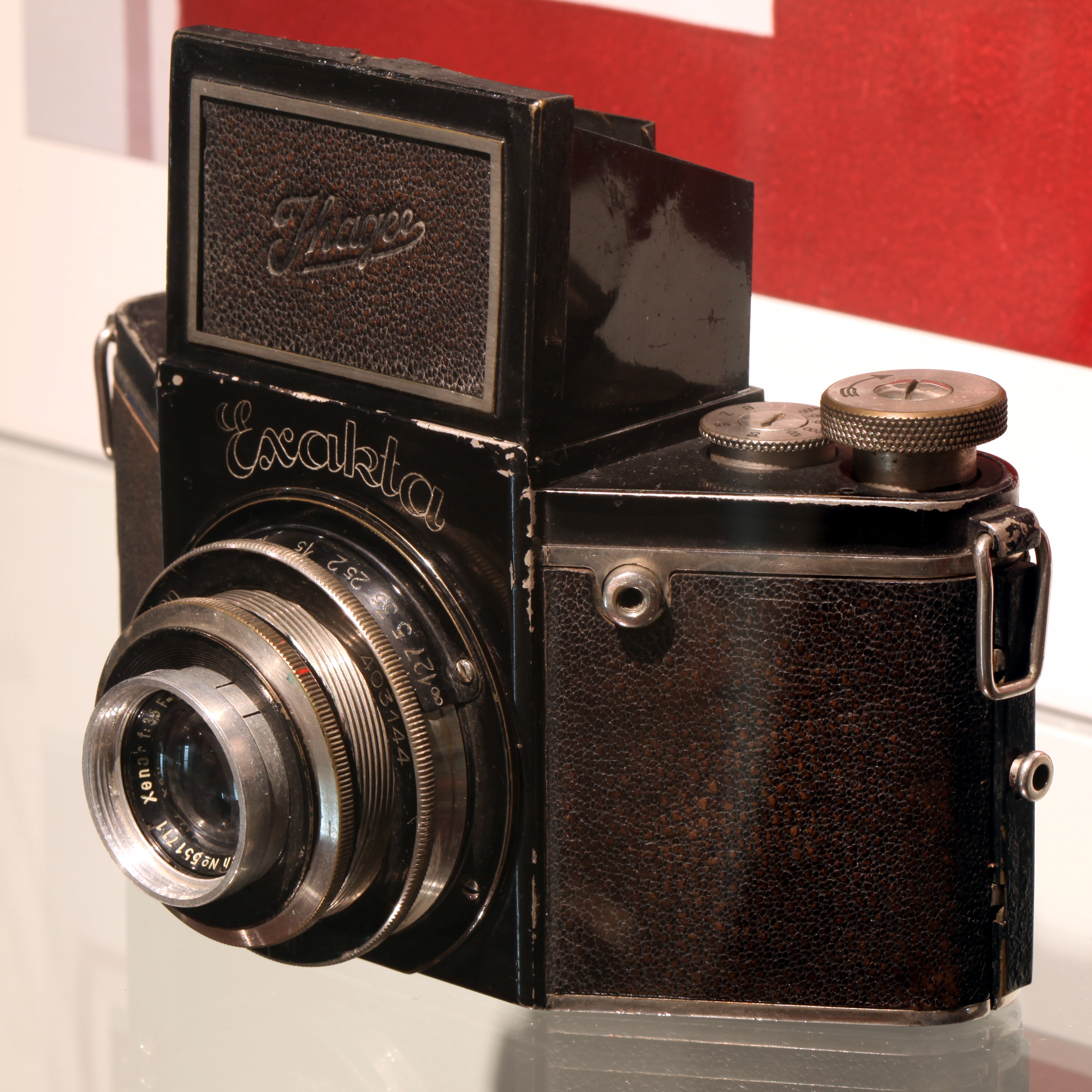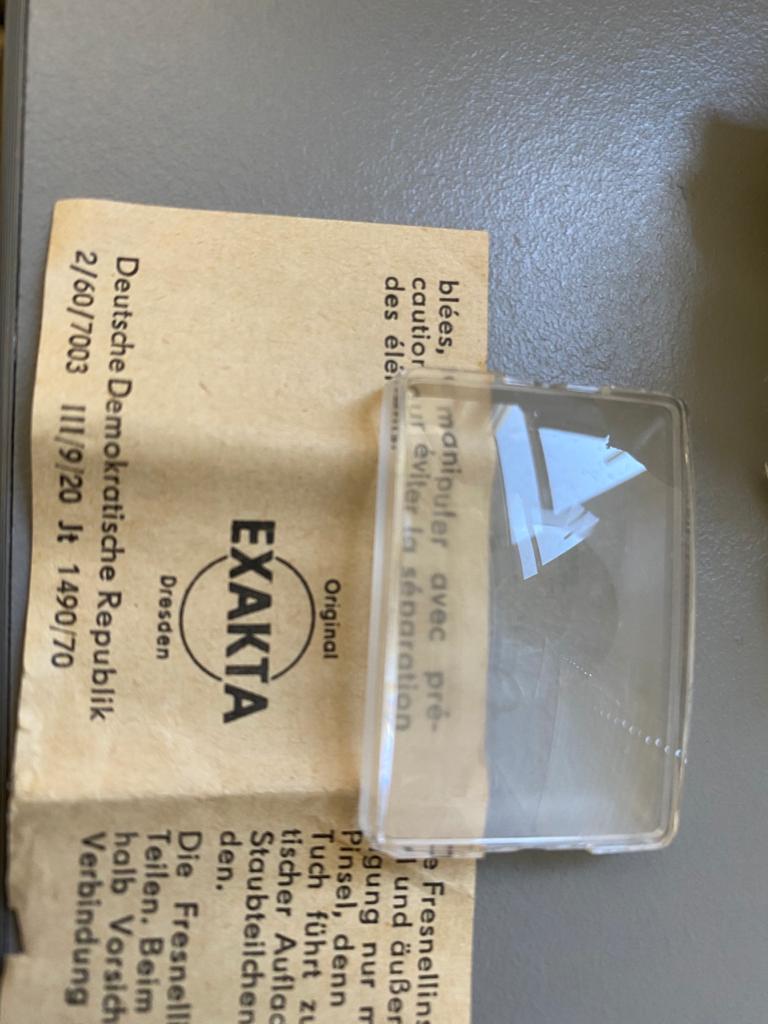Exakta GmbH on:
[Wikipedia]
[Google]
[Amazon]

 The Exakta (sometimes Exacta) was a camera produced by the '' Ihagee Kamerawerk'' in Dresden, Germany, founded as the Industrie und Handels-Gesellschaft mbH, in 1912. The inspiration and design of both the VP Exakta and the Kine Exakta are the work of the Ihagee engineer Karl Nüchterlein (see Richard Hummel's Spiegelreflexkameras aus Dresden), who did not survive the Second World War.
An Exakta VX was used by
The Exakta (sometimes Exacta) was a camera produced by the '' Ihagee Kamerawerk'' in Dresden, Germany, founded as the Industrie und Handels-Gesellschaft mbH, in 1912. The inspiration and design of both the VP Exakta and the Kine Exakta are the work of the Ihagee engineer Karl Nüchterlein (see Richard Hummel's Spiegelreflexkameras aus Dresden), who did not survive the Second World War.
An Exakta VX was used by
 The shutter release on classic Exaktas is on the front of the camera, rather than the top. It is pressed with the left forefinger. Amongst others, Topcon would use this bajonet mount for a time. This is quite similar to the Praktica design (which adapted it from Ihagee's product), the shutter-release of which was located on the right-hand side of the camera-body front. Most later lenses produced for Exaktas (Ihagee did not produce their own lenses), known either as "automatic" or "semi-automatic" lenses, included a button in an extension that would align over the camera body's shutter release when the lens was mounted. The diaphragm of these lenses remained fully open, providing a bright viewfinder image, until the button was depressed halfway, when the iris would be stopped down to the shooting aperture; pressed farther, the lens button engaged the camera's shutter release button, tripping the shutter.ibenda
The shutter release on classic Exaktas is on the front of the camera, rather than the top. It is pressed with the left forefinger. Amongst others, Topcon would use this bajonet mount for a time. This is quite similar to the Praktica design (which adapted it from Ihagee's product), the shutter-release of which was located on the right-hand side of the camera-body front. Most later lenses produced for Exaktas (Ihagee did not produce their own lenses), known either as "automatic" or "semi-automatic" lenses, included a button in an extension that would align over the camera body's shutter release when the lens was mounted. The diaphragm of these lenses remained fully open, providing a bright viewfinder image, until the button was depressed halfway, when the iris would be stopped down to the shooting aperture; pressed farther, the lens button engaged the camera's shutter release button, tripping the shutter.ibenda
 There was a full line of specialized equipment available for these system cameras that included microscope adaptor, extension bellows,
There was a full line of specialized equipment available for these system cameras that included microscope adaptor, extension bellows, 

Ihagee & Exakta Products and History
Andrzej Wrotniak's site on the small-format (135 or "35mm") cameras and accessories
Exakta VP Sliding Pages
35mm Exakta Sliding Pages
by Stephen Rothery
Marc's Classic Cameras
The Official Site of the Exakta Circle, founded in 1990
Defunct photography companies of Germany German brands Photography in East Germany Products introduced in 1912 SLR cameras

 The Exakta (sometimes Exacta) was a camera produced by the '' Ihagee Kamerawerk'' in Dresden, Germany, founded as the Industrie und Handels-Gesellschaft mbH, in 1912. The inspiration and design of both the VP Exakta and the Kine Exakta are the work of the Ihagee engineer Karl Nüchterlein (see Richard Hummel's Spiegelreflexkameras aus Dresden), who did not survive the Second World War.
An Exakta VX was used by
The Exakta (sometimes Exacta) was a camera produced by the '' Ihagee Kamerawerk'' in Dresden, Germany, founded as the Industrie und Handels-Gesellschaft mbH, in 1912. The inspiration and design of both the VP Exakta and the Kine Exakta are the work of the Ihagee engineer Karl Nüchterlein (see Richard Hummel's Spiegelreflexkameras aus Dresden), who did not survive the Second World War.
An Exakta VX was used by James Stewart
James Maitland Stewart (May 20, 1908 – July 2, 1997) was an American actor and military pilot. Known for his distinctive drawl and everyman screen persona, Stewart's film career spanned 80 films from 1935 to 1991. With the strong morality h ...
's character, a professional photographer, to spy on his possibly murderous neighbor in Alfred Hitchcock
Sir Alfred Joseph Hitchcock (13 August 1899 – 29 April 1980) was an English filmmaker. He is widely regarded as one of the most influential figures in the history of cinema. In a career spanning six decades, he directed over 50 featur ...
's '' Rear Window''.
Characteristics
Highlights of Exakta cameras include: * Firstsingle-lens reflex camera
A single-lens reflex camera (SLR) is a camera that typically uses a mirror and prism system (hence "reflex" from the mirror's reflection) that permits the photographer to view through the lens and see exactly what will be captured. With twin le ...
(SLR) for 127 roll film (VP Exakta) came in 1933
* First wind-on lever in 1934
* First built-in flash socket, activated by the shutter, in 1935
* First SLR for 35mm film 35 mm may refer to:
* 135 film, a type of still photography format commonly referred to as 35 mm film
* 35 mm movie film, a type of motion picture film stock
* 35MM 35 mm may refer to:
* 135 film, a type of still photography format ...
came in 1936, the Kine Exakta
Early Kine Exaktas had a fixed waist-level viewfinder, but later models, starting with the Exakta Varex, had an interchangeable waist- or eye-level finder. Examat and Travemat through-the-lens metering prisms were introduced in the mid-1960s. Most controls—including the shutter release and the film wind lever—are on the left-hand side, unlike most other cameras. The film is transported in the opposite direction to other 35mm SLRs. In classic Exaktas—made between 1936 and 1969—two film canisters can be used, one containing unexposed film and a second into which is wound the exposed film. A sliding knife built into the bottom of the camera can be used to slice the film so that the canister containing the exposed film can be removed while preserving the unexposed film in the main canister. The knife was omitted in the Exakta VX500, one of the last "official" Exakta cameras.
 The shutter release on classic Exaktas is on the front of the camera, rather than the top. It is pressed with the left forefinger. Amongst others, Topcon would use this bajonet mount for a time. This is quite similar to the Praktica design (which adapted it from Ihagee's product), the shutter-release of which was located on the right-hand side of the camera-body front. Most later lenses produced for Exaktas (Ihagee did not produce their own lenses), known either as "automatic" or "semi-automatic" lenses, included a button in an extension that would align over the camera body's shutter release when the lens was mounted. The diaphragm of these lenses remained fully open, providing a bright viewfinder image, until the button was depressed halfway, when the iris would be stopped down to the shooting aperture; pressed farther, the lens button engaged the camera's shutter release button, tripping the shutter.ibenda
The shutter release on classic Exaktas is on the front of the camera, rather than the top. It is pressed with the left forefinger. Amongst others, Topcon would use this bajonet mount for a time. This is quite similar to the Praktica design (which adapted it from Ihagee's product), the shutter-release of which was located on the right-hand side of the camera-body front. Most later lenses produced for Exaktas (Ihagee did not produce their own lenses), known either as "automatic" or "semi-automatic" lenses, included a button in an extension that would align over the camera body's shutter release when the lens was mounted. The diaphragm of these lenses remained fully open, providing a bright viewfinder image, until the button was depressed halfway, when the iris would be stopped down to the shooting aperture; pressed farther, the lens button engaged the camera's shutter release button, tripping the shutter.ibenda
 There was a full line of specialized equipment available for these system cameras that included microscope adaptor, extension bellows,
There was a full line of specialized equipment available for these system cameras that included microscope adaptor, extension bellows, stereo
Stereophonic sound, or more commonly stereo, is a method of sound reproduction that recreates a multi-directional, 3-dimensional audible perspective. This is usually achieved by using two independent audio channels through a configuration ...
attachments, medical attachments and various specialized finder screens. Equipment is fully compatible between all models manufactured between 1936 and 1969. The spelling found on cameras has traditionally been ''Exakta,'' but some early Kine-Exaktas were marked ''Exacta'' specifically for marketing in France, Portugal and the U.S., perhaps for copyright reasons; and certainly a great number of American collectors refer to the whole range as the "Exacta." A related line of smaller, simpler cameras was the "Exa" line; these, too, existed in several variations. The Beseler Topcon line of 35mm cameras used the same lens mount as the Exakta. In the early 1970s the Exakta "RTL 1000" was introduced; it accepted the older models' lenses but had its own range of viewfinders, which included a model with through-the-lens light metering. M42 lens mount variants of the RTL line of cameras also appeared under the Praktica name.
After an economic collapse following Germany's reunification
German reunification (german: link=no, Deutsche Wiedervereinigung) was the process of re-establishing Germany as a united and fully sovereign state, which took place between 2 May 1989 and 15 March 1991. The day of 3 October 1990 when the Ge ...
, the successor of the firm (Pentacon
Pentacon is the company name of a camera manufacturer in Dresden, Germany.
The name Pentacon is derived from the brand Contax of Zeiss Ikon Kamerawerke in Dresden and Pentagon, as a Pentaprism for Single-Lens Reflex (SLR) cameras was for ...
, which subsumed Ihagee) is now back in business. This company is not related to the Dutchman Johan Steenbergen, the founder of Ihagee, or with the Exakta, which was discontinued in the 1970s.


See also
* History of the single-lens reflex camera * Ihagee * Kine Exakta * Praktica * Zeiss IkonReferences
Further reading
* ''Exakta Cameras 1933–1978'', Aguila, Clément and Michel Rouah, 1989, Hove Photo Books, Hove, East Sussex * ''Collecting and Using Classic SLRs'', Matanle, Ivor, 1997, Thames and Hudson, New York, * ''Exakta Collection 1933-1987'', Clément Aguila & Michel Rouah - DDP Image Edition, France, 2003. * ''Spiegelreflexkameras aus Dresden'', Richard Hummel, Spiegelreflexkameras aus Dresden. Edition Reintzsch Leipzig, 1995, {{ISBN, 3-930846-01-2 or 3-89506-127-1External links
Ihagee & Exakta Products and History
Andrzej Wrotniak's site on the small-format (135 or "35mm") cameras and accessories
Exakta VP Sliding Pages
35mm Exakta Sliding Pages
by Stephen Rothery
Marc's Classic Cameras
The Official Site of the Exakta Circle, founded in 1990
Defunct photography companies of Germany German brands Photography in East Germany Products introduced in 1912 SLR cameras